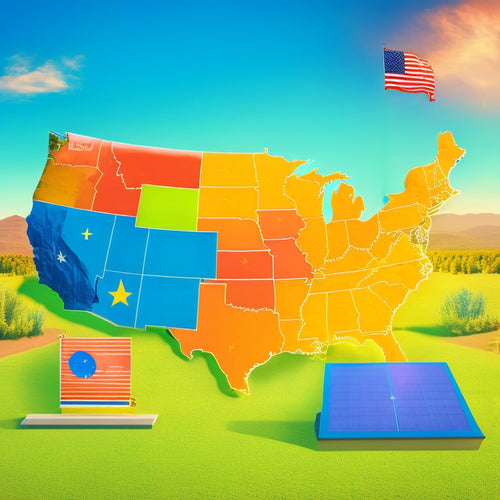
Why Higher Upfront Costs Are Worth It
Share
You pay a premium for high-quality, energy-efficient products, but they're worth it. With durability testing ensuring they can withstand real-world conditions, you'll replace them less frequently, reducing waste and saving money. Energy-efficient products can save you up to 30% on energy bills annually, which more than makes up for the initial cost difference. Plus, you'll benefit from extended warranties, enhanced property value, and government incentives. It's an investment that pays off in the long run, and there's more to explore about how these benefits can add up to significant savings over time.
Key Takeaways
• Higher upfront costs lead to longer product lifespans, reducing waste and saving money in the long run.
• Energy-efficient products can save up to 30% on energy bills annually, offsetting initial costs over time.
• Extended warranties and reduced maintenance needs minimize downtime and costly repairs, providing long-term peace of mind.
• Investing in energy-efficient upgrades increases property value and appeal, attracting potential buyers or renters.
• Government incentives and tax credits, such as the Solar ITC, can significantly offset the higher upfront costs of energy-efficient upgrades.
Higher Quality Means Longer Lifespan
By investing in higher-quality products or materials, you can expect a significant extension of their lifespan, often by 2-5 times or more, depending on the specific item and usage. This is because high-quality products undergo rigorous durability testing, which simulates real-world conditions to make sure they can withstand the test of time. As a result, you'll replace them less frequently, reducing waste and saving you money in the long run.
Material selection plays an essential role in determining a product's lifespan. For instance, using high-grade stainless steel instead of regular steel can increase a product's lifespan by up to 3 times. Similarly, opting for durable materials like fiberglass or high-impact plastics can notably extend the lifespan of a product.
Increased Energy Savings Over Time
You can save up to 30% on your energy bills annually by opting for energy-efficient products, which more than offsets the higher upfront costs over time. This significant reduction in energy expenditure is achieved through peak usage reduction, which occurs when energy-efficient systems optimize their performance during periods of high demand. By doing so, you'll not only reduce your energy bills but also contribute to a more sustainable future.
Moreover, energy-efficient products offer seasonal flexibility, allowing you to adjust your energy consumption according to changing seasonal demands. This adaptability guarantees that you're not wasting energy during periods of low demand, further reducing your energy bills.
With energy-efficient products, you'll experience a significant decrease in your energy expenditure, which will more than compensate for the higher upfront costs. By investing in energy-efficient products, you'll reap long-term benefits that will have a direct impact on your bottom line.
Warranty and Maintenance Benefits
Energy-efficient products typically come with extended warranties, which can last up to 25 years or more, ensuring that you're protected against costly repairs and replacements for an extended period. This means you can enjoy reduced downtime, minimizing the impact on your daily operations. With extended protection, you can focus on what matters most - running your business or living your life - while knowing you're covered in case something goes wrong.
Here's a breakdown of the benefits:
| Benefit | Description |
|---|---|
| Extended Protection | Up to 25 years or more of warranty coverage |
| Reduced Downtime | Minimize disruptions to your daily operations |
| Cost Savings | Avoid costly repairs and replacements |
Enhanced Property Value and Appeal
Installing energy-efficient products can greatly enhance your property's value and appeal, making it more attractive to potential buyers or renters if you decide to sell or lease in the future.
By incorporating eco-friendly features, you can increase your property's curb appeal, which is a vital factor in attracting potential buyers.
According to the National Association of Realtors, 71% of homebuyers consider energy efficiency to be an important factor when making a purchasing decision.
Government Incentives and Tax Credits
The federal government, as well as many state and local governments, offer various incentives, including tax credits and rebates, to homeowners and businesses that invest in energy-efficient upgrades. You can take advantage of these incentives to offset the higher upfront costs of green initiatives. For instance, the Solar Investment Tax Credit (ITC) allows you to claim a tax credit of 26% of the total cost of a solar panel system.
| Incentive | Description |
|---|---|
| Solar ITC | 26% tax credit for solar panel systems |
| Energy Star Rebate | Up to $500 rebate for Energy Star-certified appliances |
| State Tax Credits | Varying credits for energy-efficient upgrades, such as windows and insulation |
| Net Metering | Credits for excess energy generated by your renewable energy system |
These policy benefits can greatly reduce the cost of energy-efficient upgrades, making them more accessible to you. By taking advantage of these incentives, you can enjoy the long-term benefits of green initiatives while minimizing the upfront costs.
Frequently Asked Questions
Do Upfront Costs Vary Depending on Location and Climate?
You'll find that upfront costs vary considerably depending on your location and climate. Regional pricing, climate zones, installation fees, zoning regulations, and weather patterns all impact costs, making it essential to research local specifics before investing.
Can I Finance High-Quality Products With a Loan or Credit?
You can finance high-quality products with a loan or credit, considering interest rates, exploring loan options, and leveraging your credit scores to create tailored financial plans that empower your purchasing power.
How Do I Calculate the Return on Investment for Upfront Costs?
Did you know that 80% of businesses fail to accurately assess ROI? To compute the return on investment for upfront costs, you'll need to take into account the net benefit, cost savings, and investment timeline, making informed financial projections that drive your business forward.
Are There Any Certifications for High-Quality, Energy-Efficient Products?
You'll find certifications like Energy Labels, Industry Standards, Product Badges, and Quality Marks that guarantee high-quality, energy-efficient products, ensuring your investment yields long-term benefits and savings.
Can I Negotiate Prices With Manufacturers or Suppliers?
"Did you know that 80% of businesses negotiate prices with suppliers? You can too! By building strong supplier relationships, you'll gain price leverage, enabling you to negotiate better deals and maximize your ROI."
Related Posts
-

Why Choose Solar Car Battery Charging Systems?
You're switching to a cleaner, more sustainable transportation option by choosing solar car battery charging systems,...
-

Why Nearby EV Conversion Shops Matter to You
Having a nearby EV conversion shop means you'll experience the benefits of a more personalized, convenient, and susta...
-

3 Best State and Local Solar Incentives USA
You can greatly reduce your energy dependence and save thousands of dollars by taking advantage of the top state and ...


